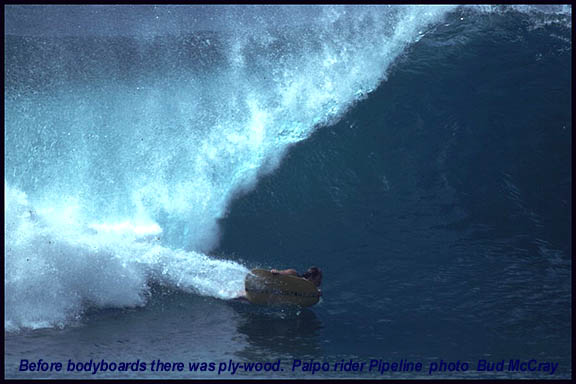
Showing what's possible on a piece of ply. Sean Ross Pipeline. Photo by McCray.
Paipo or papa paepo'o boards have their roots in Polynesia, with the most sophisticated boards and surfing occurring in Hawaii. While, the origins of the word paipo is contested, the first known written use of the word was the logo on Wally Froiseth's 1950's Pai Po boards . Clark (2011) interviewed Froiseth who stated that he coined the term from the word Hawaiians used when they referred to bodysurfing or bodysurfing with a small board - papa pae po'o (to ride a wave head first), shortened in common use to pae po. The word paipo has also referred to boards made around Newport and Huntingdon Beach, California (some of these specifically included paipo in their name:Newport Paipo, El Paipo, House of Paipo, Jacks Huntingdon Paipo) in the late 1960s-1970s.
The 2004 edition of Matt Warshaw's Encyclopedia of Surfing describes bellyboarding as "all but forgotten" by the mid 1970s and the online version doesn't have an entry for bellyboards or paipo. Warshaw did, however, acknowledge that modern surfing techniques and surfboards were influenced by the bellyboard. Richard Kenvin's 2014 book, Surfcraft, well sums up the place of bellyboards in surfing history: "The paipo maintained a link to ancient boards and riding styles while demonstrating, in the midst of the longboard era, that incredible things were possible on thin, flexible boards with little flotation ... the paipo was a testament to the power of pure planing hydrodynamics". Rod Rodger's paipo forum, Tom Wegener's passion and promotion of the alaia and the World Bellyboard championships in the UK have rekindled an interest in these boards, which for some didn't need rekindling. On Oahu in particular, there remained individuals and small groups, mostly eschewing any publicity who continued to ride paipo boards. Bellyboards are being "rediscovered" and either being ridden in new ways or their potential explored through new technologies and designs. Compared with the history of stand-up boards little has been written about paipo/bellyboards and who made or rode them. Even where there are photos, the surfers are typically not identified.The links below will take you to some of the varied approaches to riding prone.
 Showing what's possible on a piece of ply. Sean Ross Pipeline. Photo by McCray. |
| Australasia |
| Europe |
| Hawaii |
| US 1900 to 1960s |
| World |
| Youtube videos |
| Paipo Interviews |
Corrections as well as contributions of photos or information are welcomed. All copyright of respective credited source, where listed.